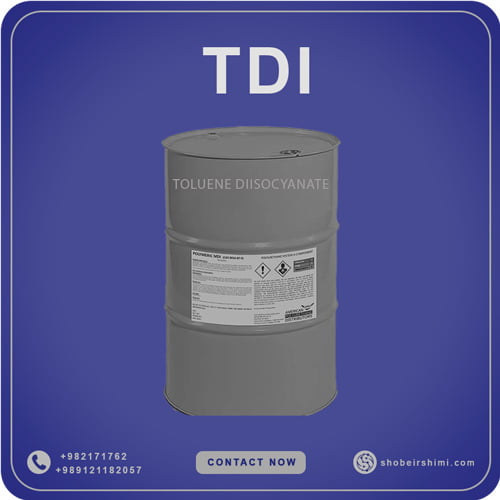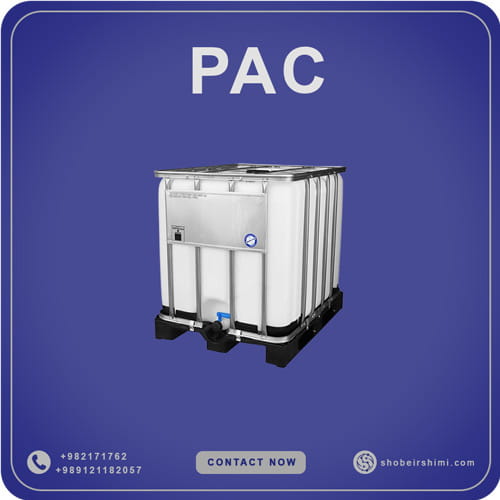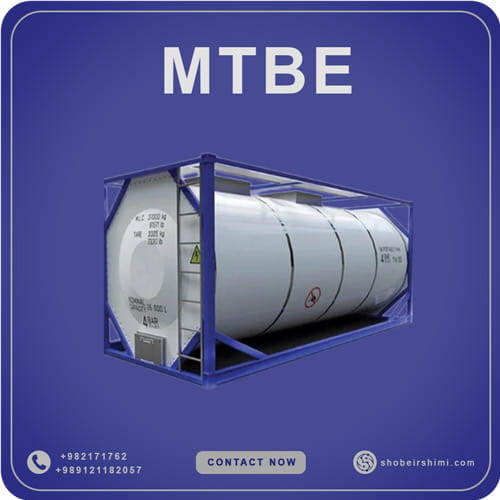- GRADE: TOLUENE DIISOCYANATE (TDI)
- Appearance: Clear liquid
- Purity, %wt: Min. 99.5
- Hydrolysable chlorine, ppm by wt: Max. 120
- Total chlorine, ppm by wt: Max. 500
- Nitro Isocyanate compounds, ppm: Max.30
- PRODUCER: Karun Petrochemical Co
- Packing details: In 220 lit (250 kg Net.)
- For purchases and inquiries, contact us on WhatsApp.
TOLUENE DIISOCYANATE (TDI) price
Description
Toluene diisocyanate (TDI) is an important organic compound used in producing polyurethane foams, elastomers, and various coatings. It is represented by the chemical formula CH₃C₆H₃(NCO)₂ and comes in two isomeric forms: 2,4-TDI and 2,6-TDI. The commercial product is a mixture of these isomers, mostly 80:20 of 2,4-TDI to 2,6-TDI. Chemical Properties and Production

Toluene diisocyanate tdi chemical formula
The two commercially significant isomers are:
- 2,4-TDI (CAS: 584-84-9)
- 2,6-TDI (CAS: 91-08-7)
TDI is synthesized from toluene. The process involves the conversion of toluene to dinitrotoluene, then reduction to 2,4-diaminotoluene (TDA), and finally phosgenation (reaction with phosgene) to produce TDI. This process generates hydrochloric acid as a byproduct
TDI is a colorless liquid at room temperature but can appear yellow in commercial samples. It has a sharp, pungent odor and can be very irritating to the eyes and respiratory system.
- Chemical Composition: TDI has the molecular formula C9H6N2O2C9H6N2O2 and is characterized by its pungent odor and colorless to pale-yellow liquid form. It has a density of 1.214 g/cm³, a melting point of approximately 21.8°C, and a boiling point of about 251°C.
- Reactivity: TDI contains isocyanate functional groups that react with hydroxyl groups to form carbamate (urethane) links. The reactivity of the 4-position is significantly higher than that of the 2-position, which influences its application in various formulations.
- High Volatility: TDI is highly volatile, producing toxic gases when combusted. This property necessitates careful handling and adherence to safety protocols during use.
TDI is primarily used in:
- Polyurethane Foam Production: A key ingredient in creating flexible and rigid polyurethane foams, commonly found in cushions, mattresses, automotive interiors, and insulation materials.
- Coatings and Adhesives: TDI is integral to the formulation of polyurethane coatings used in automotive refinishing, wood finishes, and anti-corrosive coatings.
- Elastomers: The compound is used to manufacture elastomers for various applications, including tires, adhesives, and sealants.
- Specialty Applications: TDI finds niche uses in producing shock-absorbing materials and as an intermediate in chemical synthesis for other industrial processes.



- Manufacturers of Polyurethane Products: Companies producing flexible or rigid foams for furniture, automotive, or construction industries rely heavily on TDI for its superior properties.
- Coating and Adhesive Producers: Businesses involved in manufacturing paints, varnishes, or sealants utilize TDI to enhance product performance.
- Elastomer Manufacturers: Industries focusing on rubber-like materials for tires or other applications benefit from TDI’s chemical properties.
- Chemical Processing Industries: Companies engaged in the synthesis of specialty chemicals or intermediates may use TDI as a building block.
Health RisksDespite its uses in industry TDI is very hazardous:
Toxicity: It’s classified as “very toxic” by the EU. Inhaling TDI vapor can cause severe respiratory problems, and asthma-like symptoms. Long-term exposure can cause permanent lung damage and hypersensitivity.
Carcinogenicity: Animal studies show TDI may be carcinogenic. The National Toxicology Program (NTP) lists it as “reasonably anticipated to be a human carcinogen” and the International Agency for Research on Cancer (IARC) as “possibly carcinogenic to humans” (Group 2B).
Occupational Exposure Limits: In the US OSHA has set a permissible exposure limit (PEL) for TDI of 0.02 ppm. Exceeding this can cause serious health problems including respiratory dysfunction and sensitization.
Toluene diisocyanate (TDI) can cause:
- Skin and eye irritation: Contact with TDI can cause severe burns to the skin and eyes, and prolonged contact can blind you.
- Respiratory irritation: Breathing in TDI can irritate your lungs and cause coughing, shortness of breath, and chest tightness.
- Asthma: Repeating exposure to TDI can cause asthma and even low exposure can trigger asthma attacks in people who are already sensitized.
- Lung damage: Chronic exposure to TDI can cause permanent lung damage.
- Memory and concentration problems: Repeating high exposure to TDI can cause memory and concentration problems.
- Bronchitis: Repeating exposure to TDI can cause bronchitis which can cause a cough, phlegm, and shortness of breath.
No antidote for TDI but most people recover. Serious exposure may require hospitalization.
TDI reacts with water, air moisture, polyol, and alkaline substances like ammonia and detergents.
Safety MeasuresGiven its hazardous nature TDI requires strict safety protocols when handling:
- Personal Protective Equipment (PPE): Workers should wear appropriate PPE to minimize exposure.
- Monitoring: Regular monitoring of air quality in TDI workplaces is recommended to comply with safety regulations.
- Emergency Procedures: Facilities should have procedures in place for spills or accidental exposure to minimize health risks.
Global oil prices fluctuate regularly, which affects the cost of products like Toluene Diisocyanate. As a result, we do not have a fixed price for this item. To get the most current pricing information, please contact us directly. Should you have any questions regarding the prices, please get in touch with us through WhatsApp for a prompt response.
| Property | Specification | Analytical Method |
|---|---|---|
| Appearance @ 30 °C | Clear liquid | Visual |
| Purity, %wt. | Min. 99.5 | GC |
| 2,4-TDI Content, %wt. | 80.0 ± 1.0 | ASTM D4660.00 |
| 2,6-TDI Content, %wt. | 20.0 ± 1.0 | ASTM D4660.00 |
| Total Acidity, ppm by wt. | Max. 40 | ASTM D5629.05 |
| Hydrolysable chlorine, ppm by wt. | Max. 120 | ASTM D4663.98 |
| Total chlorine, ppm by wt. | Max. 500 | ASTM D4661.03 |
| Colour (APHA) | Max.25 | ASTM D4877.04 |
| Sp.gr @ 25 °C | 1.22 ± 0.02 | ASTM D4659.03 |
| Nitro Isocyanate compounds, ppm | Max.30 | H900.5800 |







Reviews
There are no reviews yet.